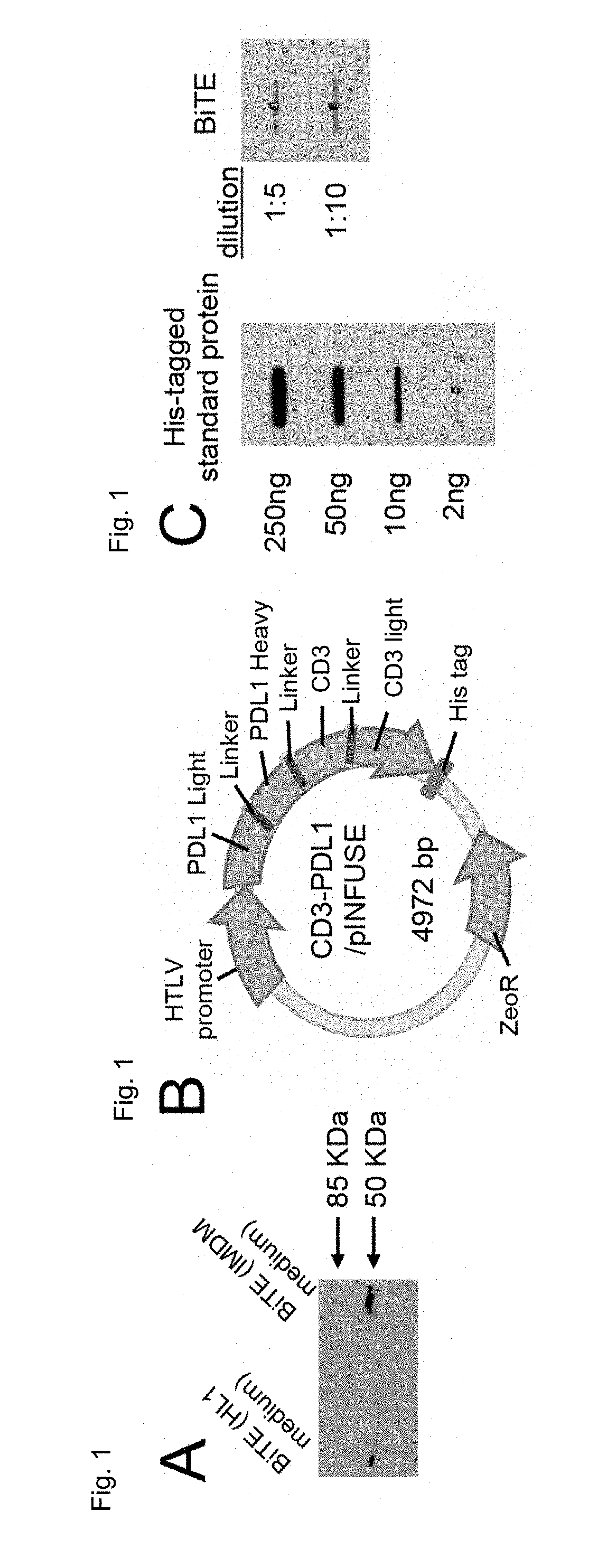Recombinant bi-specific polypeptide for coordinately activating tumor-reactive t-cells and neutralizing immune suppression
a t-cell activation and recombinant technology, applied in the field of fusion proteins, can solve the problems of not being therapeutic in all cancer patients, challenging the goal of active therapeutic vaccination to induce these immune effectors and establish immunological memory against tumor cells, etc., and achieve the effect of reducing the ability of cancer cells to bind
- Summary
- Abstract
- Description
- Claims
- Application Information
AI Technical Summary
Benefits of technology
Problems solved by technology
Method used
Image
Examples
example 1
[0085]Production of anti-CD3 / anti-PDL1 bispecific fusion protein.
[0086]The anti-CD3 / anti-PDL1 bispecific fusion protein of the present invention is a ˜55 kDa recombinant protein as assessed by western blotting (FIG. 1A). The anti-CD3 / anti-PDL1 bispecific fusion protein was produced in CHO cells transfected with the anti-CD3 / anti-PDL1 construct (FIG. 1B). To quantify the production of anti-CD3 / anti-PDL1 bispecific fusion protein by the transfectants, CHO-anti-CD3 / anti-PDL1 bispecific fusion protein cells were plated at 1×107 cells / 100 ml and supernatants were slot blotted and then stained with antibodies to the His tag. Quantification was performed using Image J software as shown in FIG. 1 C.
[0087]FIG. 2 shows that the anti-CD3 / anti-PDL1 bispecific fusion protein binds to PDL1+ human tumor cells and not to PDL1− human tumor cells. Binding activity and specificity were assessed by applying the anti-CD3 / anti-PDL1 bispecific fusion protein or an irrelevant recombinant protein (Troy Fc) ...
example 2
[0088]Cytotoxicity of 2 Chronic Myelogenous Leukemia (CML) and 2 non-CML cancer cell lines using PBMC from healthy donors and from cancer patients.
[0089]To demonstrate that the anti-CD3 / anti-PDL1 bispecific fusion protein of the present invention has therapeutic efficacy it was essential to demonstrate (i) the anti-CD3 / anti-PDL1 bispecific fusion protein activates T-cells from healthy donors; (ii) activated T-cells kill PDL1+ tumor cells and do not have off-target activity; (iii) the anti-CD3 / anti-PDL1 bispecific fusion protein activates T-cells that are cytotoxic for multiple PDL1+ human tumor cells; (iv) the anti-CD3 / anti-PDL1 bispecific fusion protein activates cytotoxic T-cells from cancer patients; and (v) the anti-CD3 / anti-PDL1 bispecific fusion protein has the ability to active CD4+, CD8+ and CD3+.
[0090](i) The anti-CD3 / anti-PDL1 bispecific fusion protein activates T-cells from healthy donors. Peripheral blood mononuclear cells (PBMC) containing T-cells from healthy human don...
example 3
[0101]The CD3xPDL1 BiTE Activates Cytotoxic PBMC From Cancer Patients
[0102]Since the goal of these studies is to determine if the CD3xPDL1 BiTE will be efficacious in cancer patients, PBMC from patients with small cell lung cancer (SCLC) and non-small cell lung cancer (NSCLC) were tested. MDSC are frequently present in the PBMC of SCLC and NSCLC patients [10, 11] and could reduce the function of the CD3xPDL1 BiTE. Using the accepted markers for identifying human MDSC [12], PBMC from three SCLC patients were screened by flow cytometry for MDSC. The leukocytes of these patients contained an average of 37.0%±11.9 total MDSC, 1.5%±1.4 monocytic MDSC (M-MDSC), and 35.5%±12.8 granulocytic MDSC (PMN-MDSC). A representative profile of a SCLC patient's PBMC stained for MDSC is shown in FIG. 13A. The percent of PBMC that were CD3+CD4+ and CD3+CD8+ T cells was also determined (FIG. 13B). To determine if the patients' PBMC could be activated by the BiTE, H358 lung adenocarcinoma cells were labe...
PUM
| Property | Measurement | Unit |
|---|---|---|
| concentrations | aaaaa | aaaaa |
| total volume | aaaaa | aaaaa |
| length | aaaaa | aaaaa |
Abstract
Description
Claims
Application Information
 Login to View More
Login to View More - R&D
- Intellectual Property
- Life Sciences
- Materials
- Tech Scout
- Unparalleled Data Quality
- Higher Quality Content
- 60% Fewer Hallucinations
Browse by: Latest US Patents, China's latest patents, Technical Efficacy Thesaurus, Application Domain, Technology Topic, Popular Technical Reports.
© 2025 PatSnap. All rights reserved.Legal|Privacy policy|Modern Slavery Act Transparency Statement|Sitemap|About US| Contact US: help@patsnap.com



